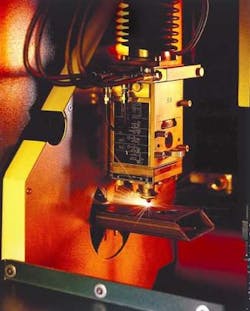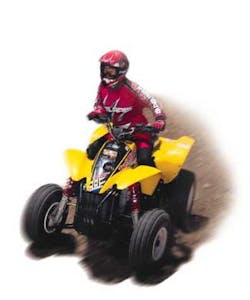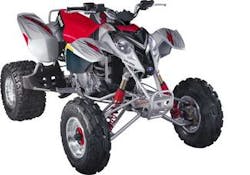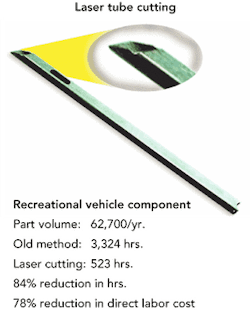In the late 1990s Polaris Industries, a recreational vehicle manufacturer, recognized that one way to meet corporate objectives of continuing to improve tube fabrication efficiency, provide increased support to the product designers and meet quality initiatives was to install an advanced tube cutting system. These vehicles have a large content of tubular components that require multiple fabrication steps before being welded into various frame, suspension and steering assemblies. Most of this tubing was processed with conventional fabricating machines that were dedicated to a particular part or part family. These machines consumed a large amount of floor space and contributed to an increased number of direct and indirect labor hours.
Some components required multiple fabrication steps before part completion. First a band saw was used to cut the components to length. Then the components were transferred to other machines that drilled holes, punched copes and slots, and machined unique-shaped openings in the tube sidewall. The last operation was usually a non-value-added step like grinding to deburr parts.
By late 1999 the manufacturing engineering department was able to identify a unique but proven laser-based tube cutting system supplied by Adige Sala (Levico, Italy), which had in 1986 pioneered the design of the first commercially available system for cutting straight raw tubes up to 21 feet long. This first-generation system was designed to cut only round tubes and was developed as an adaptation of the company's well-known cold saw.
By the time Polaris began to investigate laser tube cutting, Adige had developed a second-generation system capable of cutting round, square, rectangular, flat oval and other shape tubes. The company now has more than 200 laser tube-cutting systems installed and operating throughout Europe.
After evaluating the capabilities of the Adige LaserTube system and comparing it with its existing production processes, Polaris was able to identify significant production cost, assembly and quality improvements and other process efficiencies.
The result of the evaluation and application testing of this process confirmed the ability to streamline the tube fabrication process that would allow Polaris to consolidate, in some cases, six different fabrication steps into one continuous tube-fabricating process.
In December 2000 Polaris completed the installation of its first LaserTube system and started production on snowmobile and all terrain vehicle (ATV) frame, steering and suspension components. Within a few weeks the system was running on three full shifts, five days per week.
Cost improvements
After the first six months of operation the manufacturing engineering department performed a detailed analysis to compare actual results versus the projected benefits described in the original investment justification. The analysis compared 14 tubular production parts for snowmobiles and ATVs, looking at the conventional mechanical methods versus the new laser cutting process.
The results showed that the laser tube-cutting system removed an average of 74 percent of direct labor formerly required by Polaris' conventional machinery on an annual production volume of 650,000 parts. Many of these parts required profile shapes to be cut in one or both ends of the part in addition to two or more different shape features cut into the sidewall of the tube.
Converting the tube fabrication unit into a single fabrication process, substituting one system for multiple machines, also made it possible to dramatically simplify the production planning and control process.
Quality benefits
An immediate benefit of the laser tube-cutting system was the precision of the process. The tight axis positioning tolerances of the system provides parts that are well within drawing tolerance specifications and are considerably more consistent than tubes produced by traditional fabrication methods. Quality checks indicate the laser-cut parts were achieving a CpK value as high as 3.0. These consistent parts benefited the welding departments in the final assembly plants because they allowed throughput increase in the robotic welding cells while reducing rework.
Over the past two years the quality department has been able to reduce component inspections by 50 percent, because of the consistent results and high confidence level of the process compared to the previous conventional methods. This in turn has leveraged the available quality control resources and allowed the inspectors to focus on other types of components being produced with less-sophisticated equipment.
Reduced fabrication costs
One of the first beneficiaries of these more-consistent parts was the welding and final assembly departments, who experienced a dramatic improvement in fit-up. Laser-cut parts reduced fixturing costs, and assembly and welding cycle times were reduced by approximately 60 percent in some cases. The improved consistency of the parts produced by the laser system also helped reduce the welding reject rate.
Form and functionality
On a much broader scale, the flexibility of the laser tube-cutting systems helped fuel a new level of innovation in the product design department. Freed of the concern about future tooling costs or the need for additional costly production equipment, the product designers now have additional degrees of design freedom to experiment with advanced product form and functionality.
The product designers are relieved of many of their former design constraints, and because of the rapid-prototyping capability of the LaserTube system, the manufacturing engineering department is capable of putting newly designed tubular components in the designer's hands within 30 minutes after the design is completed. This has increased the speed to market of new products, a key element in the strategy of many market leaders like Polaris Industries.
Ease of use
The laser tube-cutting system is equipped with a user-friendly CAD/CAM system that leads the programmer through the part development process. The software is parametric—so if a change in the part is needed, it is necessary only to change the dimension as required and the rest is automatically recalculated.
The simplicity of the 3D CAD system permits the user to program a part in less than 10 minutes. The CAM system then takes this data and automatically converts the 3D data to 2D and develops the most efficient cutting path to complete the part.
Additional investments
In mid-2001, based on the early success of the first LaserTube system, Polaris gained confidence in the performance and reliability of laser tube cutting and began to explore other applications that would benefit from this process. Later that year the company installed a second LaserTube system and began laser cutting an expanded number and type of tubular components used in recreational vehicles. Before long, both laser-cutting systems were being fully utilized producing parts of exceptional quality.
In early 2002, having developed an extensive level of experience with the process, Polaris began to use the unique capabilities of the LaserTube to design its next-generation products in a way that further leveraged the efficiency of laser tube cutting. It was at that point that the production needs began to tax the two existing laser tube-cutting systems, which at the time were running at more than 90 percent of capacity on three shifts.
With additional production volume looming, the company purchased a third LaserTube system during December 2002. By this time Adige had engineered and installed a third-generation system that had the added advantages of more powerful CAD/CAM software, faster cutting speeds and even shorter setup times when changing from round to rectangular or square tubes or vise versa.
Summary
Today the three laser tube-cutting systems are approaching 6000 hours annual per machine. These laser tube machines are cutting the suspension, frame, steering and other similar components for a broad range of Polaris products, including snowmobiles, ATVs, the Ranger line of utility and sport vehicles and the company's new line of Victory motorcycles.
The installation of Adige Sala's standard, commercially available laser tube-cutting systems has helped Polaris dramatically reduce the cost of production, further improve product quality and reduced downstream welding and assembly costs. In addition, the flexibility of the system to fabricate components from different shaped tubes, the ability to cut virtually any end condition on one or both ends of the tube and cut any shape opening in the tube sidewall without tooling is providing additional design options, which in turn is driving new levels of innovation in product design.
More broadly, however, laser tube cutting is proving itself to be the most economically significant advance in tube fabrication in the last 35 years. Laser tube cutting is helping its users become more cost competitive and more innovative in response to increasing levels of both domestic and foreign competition. In most fabrication applications in mechanical tubing, laser tube cutting is now rapidly rendering conventional mechanical fabrication techniques obsolete.
Patrick A. Sheridan is manufacturing engineer, Polaris Industries, Osceola, WI, and James P. Rutt is president and COO, BLM-Adige USA Corp., Wixom, MI, sales@blmadigeusa.com.



